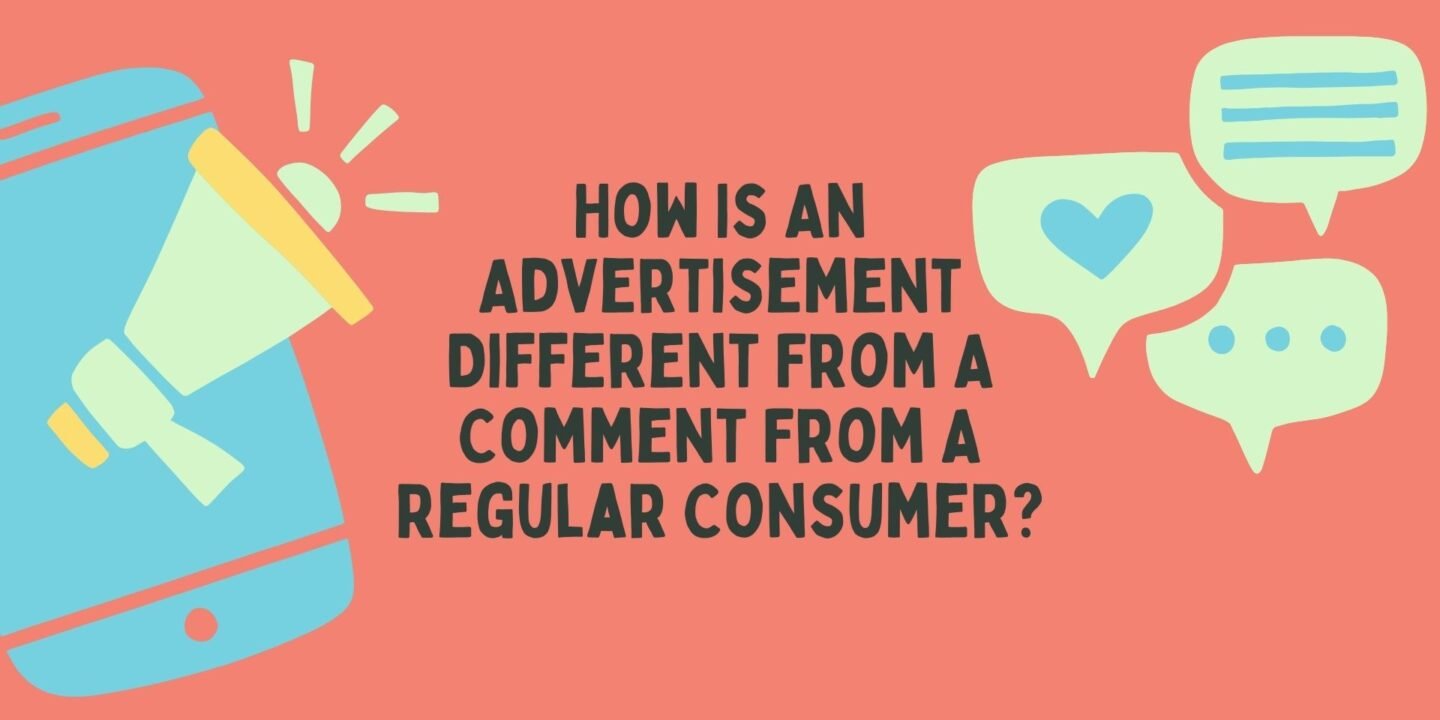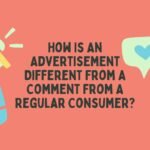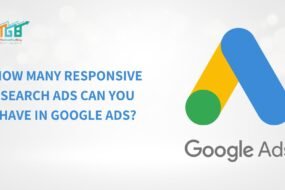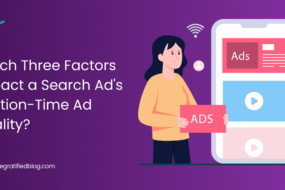
Imagine you are scrolling through your favorite social media app, and you see two posts about a new phone. One post is from the phone brand itself, showing sleek images and listing amazing features. The other post is from a friend who just bought the phone and is excited to share their experience.
Both posts are talking about the same product, but they are not the same. One is an advertisement, and the other is a comment from a regular consumer. But what makes them different? Let us explore in detail how is an advertisement different from a comment from a regular consumer?
What Is An Advertisement?
An advertisement is a message created by a company to promote a product, service, or idea. The goal is to grab attention, build interest, and encourage people to buy or take action.
Companies use different types of ads, including:
- TV commercials – Short video ads on television.
- Social media ads – Sponsored posts on platforms like Facebook, Instagram, and YouTube.
- Billboards – Large posters in public places.
- Online banner ads – Ads that appear on websites.
- Newspaper and magazine ads – Printed promotions in newspapers or magazines.
Advertisements use strong words, catchy slogans, and attractive visuals to make a product look as appealing as possible.
For example, a sports brand might say, “Run faster with our latest lightweight shoes!” This makes the product sound exciting and essential for runners.
What Is A Consumer Comment?
A consumer comment is a message shared by a regular person about a product, service, or experience. It is not created for marketing purposes but is a personal opinion based on real-life use. These comments can appear in many places, such as:
- A review on a shopping website like Amazon or eBay
- A social media post about a recent purchase
- A discussion in an online forum where people share experiences
- A casual message in a group chat with friends or family
- A rating or feedback left on a company’s website
Unlike advertisements, a consumer comment is not controlled by a company. It reflects a person’s real experience, whether positive, negative, or neutral. Many people trust these comments because they come from actual users rather than businesses trying to sell something.
How Is An Advertisement Different From A Comment From A Regular Consumer?
An advertisement and a comment from a regular consumer serve different purposes and come from different sources. Here’s how they differ:
1. Who Creates It?
- Advertisement: Created by a business or a marketer to promote a product or service. Companies spend money to design and distribute ads.
- Consumer Comment: Written by an individual who has used the product or has an opinion about it. The person is not paid to say anything.
A company has a goal of selling its product, so its ads focus on the best parts. A consumer, on the other hand, may talk about both the good and the bad.
2. Purpose of the Message
- Advertisement: The goal is to convince people to buy. Ads highlight the benefits and try to create a strong impression.
- Consumer Comment: The purpose is usually to share an experience, give an opinion, or help others make a decision.
A company might use flashy words like “best phone ever” or “limited-time offer,” while a regular consumer might say, “I liked the camera, but the battery life is not great.”
3. Tone and Language Used
- Advertisement: Often polished, professional, and persuasive. Marketers carefully choose words that make the product look as appealing as possible.
- Consumer Comment: More natural and casual. People write the way they speak, using everyday words and sometimes even slang.
For example, an ad might say, “Experience cutting-edge technology with our latest laptop.” A regular person might say, “This laptop is fast, but it gets hot after a while.”
4. Trust Factor
- Advertisement: People know ads are made to sell something, so they may not fully trust them.
- Consumer Comment: Feels more real because it comes from another buyer with no reason to lie.
Most people trust what other customers say more than what a company says. This is why brands encourage reviews and testimonials.
5. Control Over Content
- Advertisement: The company decides what goes into the ad. Every detail is planned, from the words to the images.
- Consumer Comment: The person writing the comment controls what they say. They might praise, complain, or just share a neutral opinion.
If a customer does not like a product, they will say so. A company, however, will never create an ad that mentions flaws.
6. Where You See Them
- Advertisement: Appears in places where companies pay for them to be shown. This includes TV, billboards, websites, and social media ads.
- Consumer Comment: Found in reviews, social media posts, online forums, and casual conversations.
Ads are placed strategically to catch attention. Comments appear naturally wherever people discuss a product.
7. Paid vs. Unpaid Content
- Advertisement: Businesses spend money to create and run ads. They pay for design, placement, and even influencers to promote products.
- Consumer Comment: Written for free by regular people who are not getting paid to share their views.
Some influencers or celebrities are paid to post reviews, which makes their opinions less trustworthy than an unpaid review from an everyday customer.
8. Emotions and Honesty
- Advertisement: Ads are designed to make people feel something—excitement, urgency, or even fear of missing out.
- Consumer Comment: More personal and unpredictable. A happy customer may show excitement, while a disappointed one may express frustration.
A toothpaste ad might say, “Get a bright smile in just one week!” Meanwhile, a user comment might say, “I have been using this toothpaste, but I do not see much difference.”
9. Legal and Ethical Rules
- Advertisement: Companies must follow advertising laws. They cannot make false claims or mislead people. However, some ads can still be exaggerated.
- Consumer Comment: There are no strict rules for personal opinions. However, fake reviews and misleading comments are sometimes a problem.
For example, a skincare brand cannot claim its product “removes wrinkles overnight” unless proven. But a person can say, “This cream worked wonders for me!” without proof.
10. Visual Elements
- Advertisement: Ads often include high-quality images, videos, and graphics to make the product look as attractive as possible.
- Consumer Comment: Usually plain text, sometimes with real-life photos or videos taken by the person.
A fast-food ad might show a perfect, juicy burger, but a real customer’s picture might show something that looks very different.
11. Impact on Buying Decisions
- Advertisement: Tries to create desire and urgency to make people buy immediately.
- Consumer Comment: Helps people make informed decisions by showing real experiences.
Many people check reviews before buying a product. They may like an ad, but they trust customer feedback more.
Why Understanding This Difference Matters?
Understanding the difference between ads and consumer comments helps people make smarter choices. Here is why:
- It prevents falling for marketing tricks – Advertisements are designed to make products look perfect. Knowing the difference helps people avoid misleading claims.
- It helps people find honest opinions before buying – Real customer reviews give insight into what to expect, both good and bad.
- It allows businesses to see what customers truly think – Companies can use consumer comments to improve their products or services.
- It saves money and time – Reading consumer comments before purchasing can help avoid wasting money on something that does not meet expectations.
- It creates a more informed marketplace – When people rely on both ads and real experiences, they make better purchasing decisions.
The next time you see an ad, think about whether it is showing the full picture. And when reading a comment, consider if the person is being fair, biased, or just sharing a personal experience.
Final Thoughts
Ads and consumer comments both play a role in influencing opinions. Ads create awareness, while customer feedback builds trust. Knowing the difference helps people navigate the world of marketing with more confidence.
So, before making a purchase, always check both. See what the brand says, but also listen to what real people are saying. That way, you can make the best decision for yourself.
Frequently Asked Questions
Q1. How is an advertisement different from a comment from a regular consumer?
Ans. An advertisement is a paid promotional message created by a brand to persuade consumers, while a regular consumer comment is an unpaid, personal opinion or review based on individual experience, often shared voluntarily without commercial intent.
Q2. What is the difference between consumerism and advertising?
Ans. Consumerism refers to the cultural and economic system that encourages buying goods and services, whereas advertising is a marketing tool used to promote products and influence consumer behavior through persuasive messaging.
Q3. What’s the difference between advertising and advertisement?
Ans. Advertising is the overall process of promoting products or services through various channels, while an advertisement (ad) is a specific piece of content, such as a TV commercial or online banner, created as part of an advertising campaign.
Q4. How is direct response advertising different from regular advertising?
Ans. Direct response advertising encourages immediate action, such as signing up or purchasing, using clear calls to action, while regular advertising focuses on long-term brand awareness and engagement without expecting an instant response from consumers.








No Comments